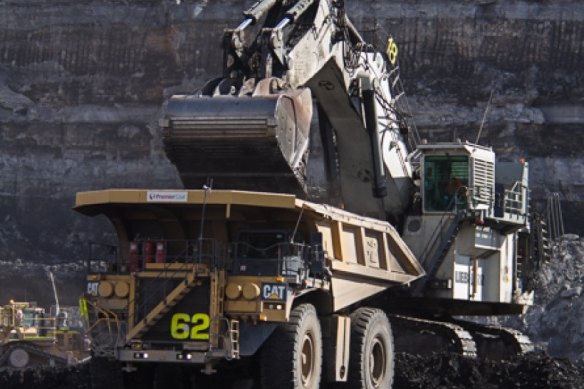- Exclusive
- National
- WA
- Power network
This was published 2 years ago
WA coal power issues predicted to last all summer
By Peter Milne
Gas-fired power generators feeding the state’s biggest electricity grid will be forced to work harder well into the summer months of 2023 to make up for issues with coal power stations in Collie that are beset with supply issues of the commodity.
The continued low coal production through the coming summer—that to date has been partly blamed on a wet winter and a safety incident at Collie’s Premier coal mine—has been revealed in a forecast of future gas demand by the Australian Energy Market Operator that was developed in consultation with major industry players.

Premier Coal supplies Synergy’s Muja and Collie power stations.Credit: Premier Coal website
In October AEMO presented a draft gas demand forecast for 2023 and beyond to its gas forecasting reference group, which is made up of representatives of large energy producers and consumers who meet before the final forecast is released in December.
The feedback from the group—that usually includes employees of state-owned generate Synergy—was that AEMO’s assumption that the output of WA’s three coal-fired power stations would return to normal in January 2023 was wrong.
AEMO has day-to-day control of power generation on the South West Interconnected System, which is the grid that provides power to homes and businesses that spans the area between Kalbarri, Albany and Kalgoorlie and includes Perth.
The forecast implies that AEMO expects planned coal imports will not fully recoup lost production from Collie’s two coal miners Premier and Griffin that are weighed down with debt and face rising costs as the overburden to be removed to produce each tonne of coal rises each year.
Synergy shut its Collie power station for three months until January to build up its coal stockpile for expected peak demand during the hotter summer months of January and February.
The prediction comes even after Synergy confirmed plans to begin importing coal this year from New South Wales for its Collie and Muja power stations normally supplied by Premier.
WA’s third coal-fired power station, privately-owned Bluewaters, is supplied by Griffin.
In early November AEMO presented to an industry group a higher forecast of about an extra 60 terajoules a day of gas consumption in 2023 with smaller increases in the following three years.
While the increased gas use is a small part of WA’s total demand that is dominated by industry, it represents about a 50 per cent increase in gas used to generate power in the SWIS.
In October gas provided 39 per cent of the power on the SWIS, compared to 28 per cent a year ago, while coal’s share dropped from 34 per cent to 20 per cent.
Concerns over coal supply have pushed AEMO to secure extra generation capacity over the summer to maintain sufficient spare capacity.
Energy minister Bill Johnston said in October that coal from Collie is a fraction of the cost of coal bought on the international market.
“Synergy is not going to need to import millions of tons of coal over the next seven years,” he said.
“There may be occasions when Synergy needs to take emergency action to bring in small amounts.”
Coal demand will reduce significantly in 2027 when Synergy plans to close its Collie power station, followed by shutting down Muja in 2029.
Premier produced 3 million tonnes of coal in the 12 months to June 2021, according to its most recent report to the state environmental regulator, and Griffin sold 2.4 million tonnes.